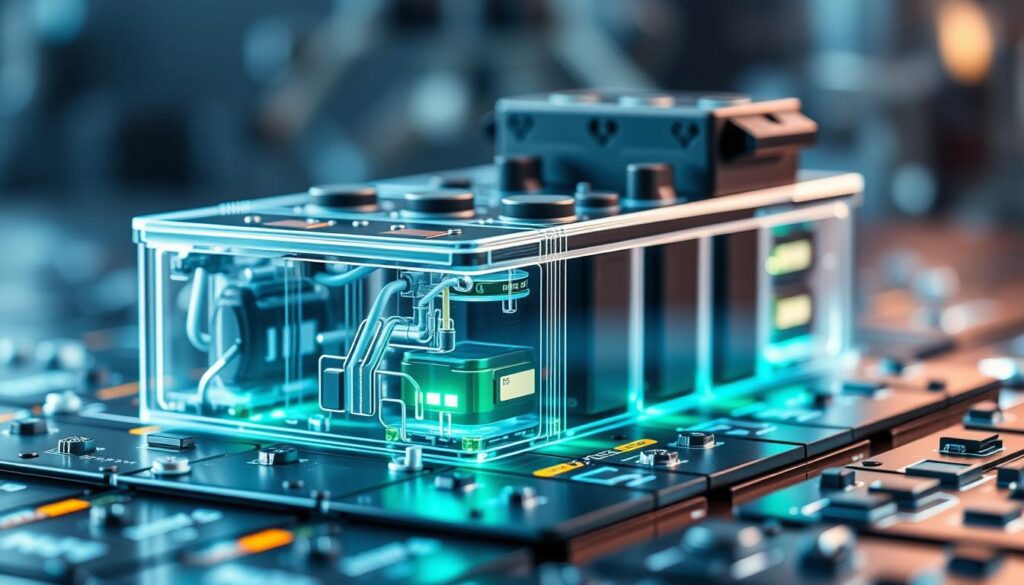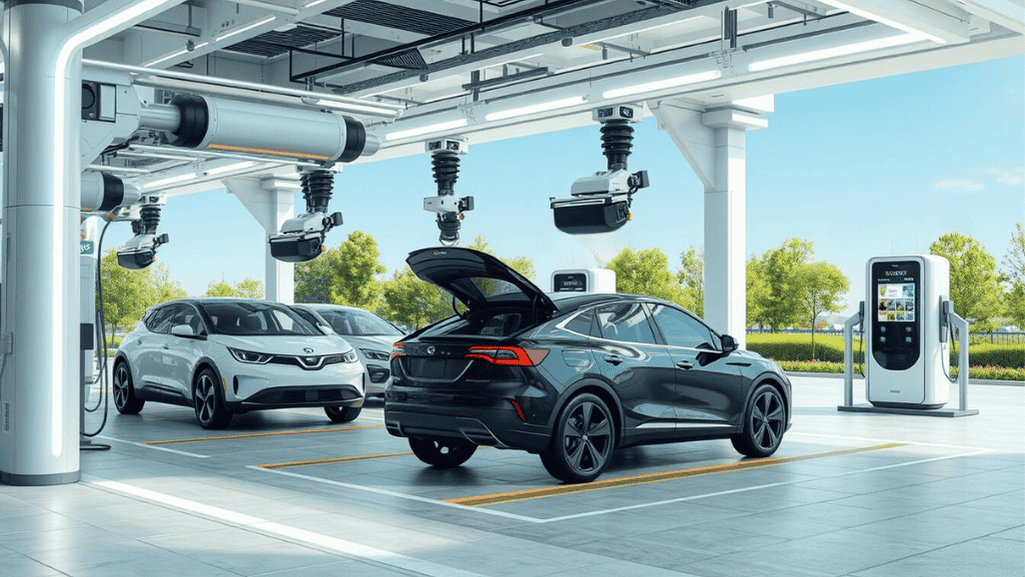The pace of innovation in electric car battery technology is changing the game. It’s all about making green transportation technology better. The value of these batteries has skyrocketed, changing the automotive industry. In 2022, the market was worth USD 49.0 billion. By 2032, it’s expected to hit USD 421.1 billion, growing at a 24% annual rate.
Advanced battery technology is key to a sustainable future. It’s what makes electric vehicles possible.
EV NextGen is a go-to site for electric vehicle news and insights. It offers expert reviews and analysis. The site is a top resource for those interested in how cars and the environment can work together.
Key Takeaways
- The electric vehicle battery market is set to grow significantly, reaching over USD 400 billion by 2032.
- Lithium-ion technology is leading the way in electric vehicles.
- Asia Pacific is leading the charge in electric vehicle batteries, showing a big shift in the market.
- Big partnerships, like Ford and CATL, or Honda’s investments, show the industry’s focus on electric car batteries.
- With governments and companies working together towards sustainability, electric vehicles are becoming more popular.
Exploring the Surge in Electric Vehicle Battery Market Value
The electric vehicle market is growing fast, thanks to better electric vehicle batteries. These batteries are expected to jump from a value of USD 44.69 billion in 2022 to a huge amount by 2030. This growth is because more people are choosing lithium-ion batteries. They are better because they hold more energy and charge faster than old batteries.
Big car companies and governments are helping by improving the charging stations. They’re doing this through EV policies and working together with private companies. Companies like BMW, General Motors, and Ford are making more electric cars. This means they need more efficient electric vehicle batteries.
Market Projection from 2022 to 2032
The future of electric vehicle batteries looks bright. They’re expected to grow more than 20% every year. Lithium-ion batteries are leading the market because they’re light and charge quickly. This makes electric cars more practical for people.
Influence of Major Automakers and EV Policies
Government policies are now supporting electric vehicles more than ever. They help public and private partnerships grow. These policies help big car companies switch to electric cars. With more charging stations, it’s easier for people to switch from gas cars to electric ones.
These changes are making the electric vehicle battery market grow fast. They’re also changing how we think about car power in the future.
The Core of Electric Car Battery Technology
Modern electric vehicles rely on the battery pack at their core. This key component has changed a lot in recent years. Inside these batteries, an electrochemical reaction is vital for power. Lithium-nickel-manganese-cobalt-oxide (NMC) is a top choice for this reaction. It balances power, life, and safety well.
BYD Motors is leading the way with new EV battery tech. Their “blade battery” improves safety and efficiency. This change helps the car perform better and supports the important electrochemical reactions inside EV batteries.
Advancements in battery technology make EVs more efficient and powerful. These improvements include more energy storage and quicker charging. These are key for making electric cars more practical and convenient for users.
The growth of battery tech is pushing for better materials and ways to make them. We’ve moved from simple batteries to advanced lithium-ion and solid-state ones. With BYD Motors leading, the future of electric car batteries looks bright. They’re working towards a sustainable, efficient, and advanced battery system.
| Battery Technology | Energy Density | Lifespan | Market Share | Notable Features |
|---|---|---|---|---|
| Lithium-nickel-manganese-cobalt-oxide (NMC) | High | Long | Dominant in electric vehicles | Balance of power, longevity, and safety |
| Lithium Iron Phosphate (LFP) | Variable | Longer | 41% Global for BEVs | Thermal stability and safety |
| Blade Battery (BYD) | High | Extended | Growing with BYD vehicles | Enhanced safety profile, packing efficiency |
| Solid-state | Highest | Unknown, assumed long | Emerging | Faster charging, increased energy capacity |
The type of electrochemical reaction in each battery affects its environmental impact and efficiency. BYD Motors is pushing the EV battery industry forward with their lithium-nickel-manganese-cobalt-oxide and other technologies. The future looks bright, with big tech advances and a focus on the environment.
Recent Developments in Battery Technology and Industry Collaborations
The electric vehicle (EV) world is changing fast. Big investments and partnerships are pushing battery technology forward. Car companies and battery makers are working together to make new discoveries and improve how they work together.
Partnerships and Investments Advancing Electric Car Battery Tech
There’s a big push into research and development in batteries. Ford is teaming up with CATL to create a $3.5 billion battery plant. This move shows Ford’s big plans for electric cars and makes CATL a key player in battery innovation.
Innovations from CATL, Clarios, and Honda
CATL is leading the way in electric car batteries. They’re working on safer, more efficient batteries with more power and less risk. Clarios has launched a new lithium-power sport battery line that could change how high-performance cars use power.
Honda is also getting into battery tech with a big investment in lithium-ion batteries with LG Energy Solution Ltd. This partnership aims to meet the growing need for EVs by making more batteries and using new tech like silicon anodes for better performance.
These partnerships show how working together can speed up innovation in electric car batteries. It helps manufacturers meet the demand for reliable and strong EVs.
Driving Factors Behind Electric Vehicle Battery Growth
The demand for electric vehicle batteries is rising fast. This is because of a big move towards sustainable energy storage solutions. With the dangers of fossil fuel dependence growing, people and governments are turning to renewable energy storage, especially in transport.
Reduced Dependence on Fossil Fuels
Switching to electric vehicles helps cut down on oil and fossil fuel use. In places with tough pollution rules, sustainable transportation like EVs are seen as key for the planet and energy safety. EVs help lower the cost of getting fossil fuels, making countries more energy independent.
Economic Implications of Rising EV Demand
The fast growth of EV adoption is changing the car industry’s finances. As battery production costs go down, electric cars are getting closer to being as cheap as cars with traditional engines. This is thanks to better batteries and more charging stations, like over 53,000 in the U.S. by 2023.
By understanding why electric vehicle batteries are growing, we can plan better for the future of electric vehicles. Lower battery costs and new battery types like LFP make electric cars a real option for more people.
Challenges Restraining Electric Car Battery Technology Expansion
The move to a sustainable car future faces big hurdles. Electric vehicles (EVs) are better for the planet, but making them costs a lot and finding the right materials is hard. This slows down how fast EVs can become common and how much they can improve.
Finding and using key minerals like lithium, nickel, and cobalt is tough. These minerals are key for EV batteries. But, getting them raises questions about cost and ethics in how they are mined and supplied.
Economic and Material Hurdles in EV Production
Getting these materials is not just about finding them. It’s also about the world’s politics and economy in mining and processing them. Countries like China play a big part in the global supply of nickel and cobalt. This makes the situation more complicated.
| Statistic | Data | Impact on EV Battery Production |
|---|---|---|
| Global EV Growth Rate Annually by 2030 | 36% | Higher demand for critical battery minerals |
| Average Travel Distance for Battery Minerals | 50,000 miles | Increased logistical costs and carbon footprint |
| Cost-saving via Smart Gap Filler Application | 20% material savings | Reduction in material costs, enhancing battery production efficiency |
| Investment in EV Battery Supply Chain Post-Inflation Reduction Act | $40 billion | Enhanced infrastructure but escalating initial capital requirements |
To fix the high production costs and supply issues, we need new ideas and more money. A detailed review on electric vehicle battery technology talks about this. It suggests improving recycling, finding new materials, and making batteries better. This could ease the strain on rare minerals and cut costs.
Without big steps forward in these areas, we might not see many electric cars on the road. The key to more EVs is using fewer rare resources and making batteries better. This is crucial to get past the current hurdles and grow electric car battery technology.
New Opportunities Presented by Battery Swapping and BaaS
The world of electric vehicles (EVs) is changing fast, thanks to new ideas like battery swapping and Battery-as-a-Service (BaaS). These ideas are changing how we think about owning cars. They offer new ways to use electric vehicles that are easier on the wallet.
With battery swapping and BaaS, the way we use electric vehicles is changing a lot. Companies like NIO and CATL are leading this change. They’re setting up swapping stations everywhere. According to Forhad, an expert in electric mobility, these changes make customers happier. They get fast service and save money upfront.
The Future of Battery-as-a-Service Models
BaaS is becoming a key part of the EV world. It lets people lease batteries instead of buying them. This makes electric cars cheaper to get started with. It also means less worry about battery life and costs.
Experts think BaaS will grow a lot, reaching $852.6 million by 2030. This growth is thanks to new ways to finance EVs. Things like selling EV battery rights and sharing revenue help make it work.
Impact on EV Adoption and Infrastructure
Battery swapping and BaaS are making charging EVs faster and easier. Swapping batteries takes only 3-5 minutes, unlike the 35 minutes for charging. This is key for more people to use electric vehicles.
Big names in cars and energy are backing battery swapping. For example, CATL and Didi are working together. This helps make BaaS better and more useful.
Companies like NIO are also making EVs more appealing. They offer discounts and flexible battery pack options. This makes electric vehicles more accessible to everyone.
Battery swapping and BaaS are changing how we use energy in EVs. They make switching to electric vehicles smoother and more sustainable. This could shape the future of how we get around.
Dissecting the Lithium-Ion Dominance in the Electric Car Battery Market
In the fast-changing world of electric car battery technology, lithium-ion batteries are key. They lead in innovation and efficiency. Their growth in specific energy and power density is pushing the electric vehicle (EV) industry forward. Knowing why lithium-ion leads gives us clues about the future and where to invest.
Lithium-ion batteries have a higher energy density than others. This is crucial for making EVs go farther without adding more weight. The technology has also gotten safer and more reliable, making people trust electric cars more.
Lithium-ion batteries are becoming cheaper, making electric cars more affordable for more people. Over the last ten years, the price per kilowatt-hour has dropped a lot. This is thanks to new battery designs and materials, like using silicon in the anodes, which also improve the battery’s performance.
Sales of electric vehicles made up 8.3% of the global market in 2022, a big jump from 2.5% in 2019, says the International Energy Agency (IEA). This growth is linked to better lithium-ion battery technology. These improvements are as big a deal as any other tech advance in cars.
Looking ahead, we’ll need more lithium, which could cause supply issues. But, recycling tech and new battery types, like solid-state batteries, are coming to help. Solid-state batteries could be even safer and more efficient, changing electric car battery technology even more.
To sum up, lithium-ion batteries are leading in the EV world with their high energy and power density. This is driving more people to choose EVs and invest in these technologies. Keeping up with these changes is crucial for those in the car and energy storage fields.
The Next Wave of Electric Car Battery Technology Innovations
Electric car battery technology is moving fast, with big steps forward in making electric vehicle batteries better and cheaper. The industry is focusing on making batteries that hold more energy, charge quickly, and are safe. These changes will change how we see and use electric vehicles around the world.
New tech is making electric vehicle batteries cheaper, safer, and more useful. Solid-state batteries are a big deal because they charge fast and hold a lot of energy. This could change electric vehicle batteries for the better, making them charge faster and last longer.
Breakthroughs in Specific Energy and Charging Rates
Companies are working on making batteries hold more energy, which means electric vehicles can go farther. NAWA’s Ultra Fast Carbon Electrode is a big step forward, making batteries more powerful. This could make electric vehicles go much farther and charge faster.
Toyota is also working on solid-state batteries that could charge in just seven minutes. This is a huge leap forward in fast charging technology.
Advancements in Safety and Cost Reduction
Electric vehicle batteries are getting safer as they evolve. Lithium iron phosphate batteries (LFPs) are cheaper to make and safer. They don’t overheat as easily. Plus, using fewer rare materials makes batteries cheaper and safer.
| Battery Type | Advantages | Disadvantages | Typical Application |
|---|---|---|---|
| Solid-State | Higher energy density, Reduced charging time | High current costs of development | Next-gen electric vehicles |
| Lithium Iron Phosphate (LFP) | Cheaper, Improved lifecycle, Lower risk of overheating | Lower energy density | Stationary grid storage, Affordable EVs |
| Sodium-Ion | Cost-effective, Abundant material | Lower energy capacity | Emerging markets, Low-cost energy storage |
This table shows how different battery types tackle battery cost, energy density, and safety. These changes will help make electric vehicles more popular and sustainable. As these technologies grow, they’ll open up new possibilities for electric vehicle batteries, leading to a cleaner and more efficient future.
Conclusion
The world of electric car battery technology is changing fast. This change is making our transportation more sustainable. Electric vehicles are becoming a big part of the car market.
They’re not just a dream for the future; they’re here now. Electric cars are key to making cars better for the planet.
Electric car batteries are getting better and better. Now, over ninety-five percent of these batteries can be recycled. This helps reduce harm to the environment.
Groups like the US Department of Energy are working hard to make EV batteries even better. They want to make them more efficient and sustainable. Electric cars are now more affordable and use less fossil fuel.
There’s a big need for minerals like lithium for electric cars. But, efforts to use less cobalt and recycle more are underway. Countries like China are leading the way in recycling.
Companies like Akira Batteries are making big strides in battery technology. They’re making electric cars more reliable and useful. This is helping us move towards a future with clean energy and less dependence on fossil fuels.
More and more people are choosing electric cars. This shows we’re heading towards a greener, more efficient way of getting around.










